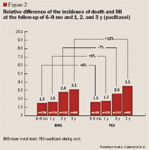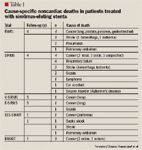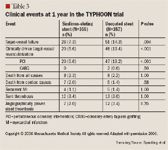- Safety & Recalls
- Regulatory Updates
- Drug Coverage
- COPD
- Cardiovascular
- Obstetrics-Gynecology & Women's Health
- Ophthalmology
- Clinical Pharmacology
- Pediatrics
- Urology
- Pharmacy
- Idiopathic Pulmonary Fibrosis
- Diabetes and Endocrinology
- Allergy, Immunology, and ENT
- Musculoskeletal/Rheumatology
- Respiratory
- Psychiatry and Behavioral Health
- Dermatology
- Oncology
Drug-eluting stents: Emerging efficacy and safety data and clinical considerations
Drug-eluting stents (DES) represent an innovative application of pharmaceutical technology that has piqued the interest of hospital and managed care decision-makers. Since their introduction to the US market in 2004, the sirolimus- and paclitaxel-eluting stents have featured drugs employing different mechanisms of action to reduce the risk of restenosis following percutaneous coronary intervention (PCI) in an attempt to improve cardiovascular outcomes.

Recent studies evaluating the use of DES in the clinical setting have given rise to significant safety concerns. In particular, the extended outcomes associated with DES have come into question as a result of 2 meta-analyses that suggest an increase in long-term death and myocardial infarction (MI). According to researchers, these cardiovascular events appear to be the result of an increased rate of in-stent thrombosis with the DES. An increase in noncardiac mortality was also observed with the sirolimus-eluting stent in 1 of the analyses.
Trials involving these devices have also yielded variable results in terms of efficacy. In recently published randomized, controlled trials, the paclitaxel-eluting stent demonstrated nonsignificant reductions in rates of target-lesion revascularization, death, and reinfarction, whereas the sirolimus-eluting stent demonstrated a significant reduction in the rate of target-vessel revascularization, with nonsignificant reductions in the rates of death and reinfarction.
The collection of clinical news that follows includes recent data presented at the European Society of Cardiology's 15th World Congress of Cardiology in Barcelona, Spain, as well as studies published in the New England Journal of Medicine.
DES meta-analyses find long-term increases in clinical events
Wayne Kuznar
Two meta-analyses suggest an increase in long-term death and myocardial infarction (MI) in recipients of first-generation DES as a result of late in-stent thrombosis. One of the meta-analyses indicates an increase in noncardiac mortality with a sirolimus-eluting stent. The findings were presented at the 15th World Congress of Cardiology in Barcelona, Spain.
These meta-analyses follow a report from a randomized clinical trial presented earlier this year in which DES were associated with an increase in late clinical events compared with bare metal stents.
Following presentation of the data in Barcelona, the authors of the meta-analyses and other prominent physicians in cardiology called for a re-evaluation of DES.
In switching from bare metal to DES, "you're trading restenosis, which is a relatively benign disorder, for late thrombosis, which is a very malignant or fatal disorder," said Steve Nissen, MD, chief of cardiology at the Cleveland Clinic and president of the American College of Cardiology.
The clinical findings are already having an impact at hospitals, said Dr Nissen, with fewer now opting for DES. "There's a subtle trend in the United States back toward bare metal stents as people get uneasy about this problem," he said.
Furthermore, decisions must now be made on extending the duration of dual antiplatelet therapy (aspirin and clopidogrel) in recipients of DES to combat the problem of in-stent thrombosis. Currently, 6 million patients worldwide have received a DES.
Dr Nissen said that he has seen clinical events in patients with DES who come off their antiplatelet regimen to undergo surgery.
Guidelines in the United States recommend a minimum of 3 or 6 months of dual antiplatelet therapy, depending on which DES is used, and up to 12 months in patients without an obvious risk of bleeding.
"I would just be guessing, but I would leave patients on clopidogrel and aspirin for longer than a year," said Salim Yusuf, MD, a strong critic of the rapid uptake of DES in clinical practice. The prospect of lifelong dual antiplatelet therapy entered into the discourse in Barcelona, even though such strong antiplatelet therapy would increase bleeding risk.
Dual antiplatelet therapy does not solve the problem of in-stent thrombosis entirely, however, as some patients who experience a clinical event with a DES have done so while still on dual antiplatelet therapy.
Case reports and autopsy studies offered the first glimpse into potential problems with in-stent thrombosis with DES. Then in March, at the annual meeting of the American College of Cardiology, the results of BASKET-LATE (Basel Stent Kosten Effektivitäts Trial-Late Thrombotic Events) were presented. This study demonstrated that, over 7 to 18 months of follow-up, the rate of cardiac death and nonfatal myocardial infarction (MI) was significantly greater (P=.01) in patients receiving a DES than in those receiving a bare metal stent.
At the World Congress of Cardiology, Edoardo Camenzind, MD, presented the results of a meta-analysis of randomized trials of sirolimus- and paclitaxel-eluting stents, looking specifically at rates of death and Q-wave MI (when these data were made available). The trials included were 4 with the sirolimus-eluting stent (RAVEL, SIRIUS, E-SIRIUS, and C-SIRIUS) and 5 from the TAXUS program with the paclitaxel-eluting stent (TAXUS I, TAXUS II, TAXUS IV, TAXUS V, AND TAXUS VI).
At the latest available follow-up for each trial (up to 3 years), compared with bare metal stents, the relative risk of death or Q-wave MI was 38% greater with the sirolimus-eluting stent (3.9% vs 6.3%; P=.03) and 16% greater with the paclitaxel-eluting stent (2.3% vs 2.6%; P=.68).
In-stent thrombosis "is likely to be under-reported, since if people die on the street, they don't fulfill the angiographic criteria to be classified as in-stent thrombosis," said Dr Camenzind, associate professor of cardiology at University Hospital, Geneva, Switzerland.

The second meta-analysis included 17 randomized controlled trials with follow-up of 1 to 4 years in which sirolimus- or paclitaxel-eluting stents were compared with bare metal stents. The purpose was to compare total, cardiac, and noncardiac mortality between the bare metal and DES.


"Drug-eluting stents for the treatment of coronary artery disease do not reduce total mortality when compared with bare metal stents. Long-term follow-up and assessment of cause-specific deaths in patients receiving drug-eluting stents are mandatory to determine long-term safety of these devices," he said. "At this time, we can't prove a causal relationship, only a statistical association. What makes me concerned is how difficult it was to obtain these data from the manufacturer."
In a 3-year follow-up of 8,146 patients who received a first-generation DES, "the incidence of late stent thrombosis did not diminish but rather continued at a steady rate of 0.6% per year," said Peter Wenaweser, MD, at University Hospital in Bern, Switzerland. Twenty-three percent of patients were still on dual antiplatelet therapy at the time of their stent thrombosis, whereas 26% were off antiplatelet therapy altogether.
A balanced and independent working group to evaluate the role of DES and other devices was requested by Dr Yusuf, professor of medicine and chair in cardiology, McMaster University, Hamilton, Ontario.
The effects of DES are not fully understood, he said, and the increased incidence of cancers with the sirolimus-eluting stent is a cause for concern. A rapid impairment of the immune system could be one explanation; release of the stent coatings for much longer than anticipated is another.
For now, limited use of DES is judicious, said Dr Yusuf. This use would include patients with a high risk of restenosis following percutaneous coronary intervention (PCI).
A new analysis from BASKET-LATE indicates that only patients with small vessels or stents (<3 mm) or bypass vessels derive benefit from DES. In an 18-month analysis of BASKET-LATE, 268 patients were treated with small stents or for bypass graft disease, and 558 were treated for large native vessels.
Freedom from major adverse coronary events (a composite of death, MI, and target vessel revascularization) was superior with DES compared with bare metal stents (P=.001) only in the population with small vessels/stents or bypass graft PCI, said Christian Kaiser, MD, University Hospital Basel, Basel, Switzerland.
Sigmund Silber, MD, professor of medicine at the University of Munich, emphasized that clinical end points, not late loss of lumen diameter, should be the standard for measuring safety of DES. Unfortunately, clinical data are not available from all of the studies performed with DES.
Furthermore, the different definitions of stent thrombosis in the trials make comparisons between devices difficult. Some have used angiographic stent thrombosis as an end point, but only survivors can be called when using such an end point, he pointed out.
Dr Silber cautioned that only patients likely to be compliant with their antiplatelet regimens should be considered for a DES, considering the apparent need for prolonged dual antiplatelet therapy. When doing cost-effective analyses of various PCI approaches, the cost of extended use of clopidogrel should be factored into the analyses, he said.
In the end, better technologies are needed, said Dr Silber. These may eventually come in the form of bioabsorbable stents or stents with bioabsorbable polymers.
Two DES demonstrate differing results in prevention of revascularization, death, and reinfarction
Mike Pangrace
Two studies recently published in the New England Journal of Medicine reported mixed results for the 2 commercially available DES in patients undergoing primary percutaneous intervention (PCI) after acute myocardial infarction (MI).
In the Paclitaxel-Eluting Stent versus Conventional Stent in Myocardial Infarction with ST-Segment Elevation (PASSION) trial, the paclitaxel-eluting stent demonstrated nonsignificant reductions in rates of target-lesion revascularization, death, and reinfarction. These results are in comparison to those of the Trial to Assess the Use of the Cypher Stent in Acute Myocardial Infarction Treated with Balloon Angioplasty (TYPHOON), in which the sirolimus-eluting stent demonstrated a significant reduction in the rate of target-vessel revascularization, with nonsignificant reductions in the rates of death and reinfarction.
In the PASSION trial, Laarman et al randomly assigned 619 patients presenting with an acute MI with ST-segment elevation to receive either a paclitaxel-eluting stent or 1 of 2 uncoated stents. A composite of death from cardiac causes, recurrent MI, or target-lesion revascularization at 1 year served as the primary end point in the trial. No further angiography was performed in the study, which concluded after 1 year of follow-up.

In TYPHOON, Spaulding et al randomly assigned 712 patients undergoing primary PCI for acute MI with ST-segment elevation to receive either a sirolimus-eluting stent or any other uncoated stent. The primary end point in the trial was target-vessel failure at 1 year after the procedure, defined as target-vessel-related death, recurrent MI, or target-vessel revascularization. Angiography was conducted at 8 months in a subpopulation of the participants (n=174) for further evaluation of clinical outcomes.

In an accompanying editorial, Frans Van de Werf, MD, PhD, of the University of Leuven, Leuven, Belgium, said that the studies demonstrated similar results to previous analyses of the stents-lower rates of restenosis and repeated intervention with the sirolimus-eluting stent without significant differences in MI or death-and suggested reasons for this difference. Dr Van de Werf highlighted the fact that in the PASSION trial the DES was compared only with 2 similar uncoated stents, whereas in TYPHOON the DES was compared with a number of uncoated stents. "This discrepancy may explain why the rates of repeated revascularization in the uncoated-stent group were higher in the TYPHOON trial than in the PASSION trial," Dr Van de Werf stated. "It may also explain the statistical difference in this end point." The follow-up angiography conducted in TYPHOON also was cited by Dr Van de Werf as a possible cause of additional revascularization procedures in the trial and subsequent statistical differences between the sirolimus-eluting stent and uncoated stent groups.
Dr Van de Werf further commented on the utility of these results when choosing a stent for use in clinical practice: "It would be dangerous to conclude from these data that one DES is better than the other in primary PCI, since direct comparisons of the 2 stents for this indication are not available."
SOURCES Spaulding C, Henry P, Teiger E, et al, for the TYPHOON Investigators. Sirolimus-eluting versus uncoated stents in acute myocardial infarction. N Engl J Med. 2006;355:1093–1104.
Laarman GJ, Suttorp MJ, Dirksen MT, et al. Paclitaxel-eluting versus uncoated stents in primary percutaneous coronary intervention. N Engl J Med. 2006;355:1105–1113.
Van de Werf F. Drug-eluting stents in acute myocardial infarction. N Engl J Med. 2006;355:1169–1170.
Everolimus-eluting stent trial offers positive angiographic data but fails to confirm clinical superiority
Wayne Kuznar
An everolimus-eluting stent was superior to the paclitaxel-eluting stent in preventing in-stent loss at 6 months, reported Patrick Serruys, MD, PhD, lead investigator of a trial known as SPIRIT II, at the 15th World Congress of Cardiology in Barcelona, Spain.
Designed as a non-inferiority trial, SPIRIT II demonstrated superiority of the everolimus stent over the paclitaxel stent on the primary end point. Three hundred patients who had de novo coronary stenoses of less than 28 mm in vessels that were 2.5 to 4.25 mm in diameter were randomized to either the everolimus-eluting stent or the paclitaxel-eluting stent in a 3:1 ratio.
At 6 months, in-stent loss-the primary end point-was 0.11 mm with the everolimus-eluting stent compared with 0.36 mm for the paclitaxel-eluting stent (P<.0001).
Secondary end points also favored the everolimus-eluting stent, including significantly better neointimal volume (P<.0001) and percent volume reduction (P<.001) with the everolimus-eluting stent, said Dr Serruys, professor of interventional cardiology, Thoraxcenter, Erasmus University, Rotterdam, The Netherlands.
Although not powered to assess event rates, the incidence of major adverse coronary events (MACE-death, myocardial infarction [MI], and the need for target-lesion revascularization) at 6 months was 2.7% in the everolimus-eluting stent group and 6.5% in the patients assigned the paclitaxel-eluting stent.
One instance of in-stent thrombosis occurred in each group.
As evidenced by 2 meta-analyses presented here, late in-stent thrombosis leading to clinical events is proving to be the Achilles heel of DES and muted the excitement of the findings.
Dr. Serruys said that the 6-month loss data from SPIRIT II may not necessarily represent an advantage to the everolimus-eluting stent given that it means that re-endothelialization is slower to occur, potentially opening the door to later problems. "It is too early to make a statement," he said.
Extended follow-up from 2 other clinical trials of DES-RAVEL and TAXUS II-demonstrated suppression of late loss with the DES compared with bare metal stents, but the difference did not translate into a clinical advantage. In fact, RAVEL demonstrated a trend toward more MACE with the sirolimus-eluting stent over 5 years.

Bernard DeBruyne, MD, from the Cardiovascular Center in Aalst, Belgium, also cautioned about the appropriateness of using restenosis as a surrogate end point. "From the data presented, it appears that there is a trend toward a higher death/Q-wave MI rate in patients treated with the sirolimus stent than in patients treated with a bare-metal stent," he said. "As long as this is not clarified by larger studies (without repeat angiogram and reporting mainly on total death rates and Q-wave MI) the suspicion will remain that the sirolimus-eluting stent cures the stenosis but harms the patient."
Four-year results from TAXUS II, presented by Antonio Columbo, MD, Columbus Hospital and San Raffaele Hospital, Milan, Italy, demonstrated no additional late in-stent thromboses (after 2 years) with the paclitaxel-eluting stent.
FDA Approves Combination Therapy for Pulmonary Arterial Hypertension
March 25th 2024J&J’s Opsynvi is single-tablet combination of macitentan, an endothelin receptor antagonist, and tadalafil, a PDE5 inhibitor. It will be priced on parity with Opsumit, which is also a J&J product to treat patients with PAH.
FDA Issues Complete Response Letter for Onpattro in Heart Failure Indication
October 9th 2023Alnylam Pharmaceuticals will no longer pursue this indication of Onpattro and will instead on focus on a label expansion for Amvuttra, which is in phase 3 development to treat patients with cardiomyopathy of ATTR amyloidosis.
